We are a team of designers, developers, researchers and educators based in Sydney, Australia.We're dedicated to creating apps for kids that are simple, engaging, innovative, and packed full of great educational content. Find us at: http://www.getshinythings.com
Don't wanna be here? Send us removal request.
Text
What’s the Deal with Maths Fact Fluency?
With the re-release of Quick Math, I thought it might be an excellent time to talk about maths fact fluency. Obviously, the principle aim of Quick Math is continued practice to improve fluency across all operations, including switching between operations.

In all likelihood, rote learning of maths facts was a feature of your mathematics education. During my early schooling years, the memorisation of basic arithmetic facts, particularly times tables, was highly valued, and lessons consisted of the demonstration of a skill, followed by endless practice exercises (well, it certainly felt endless at the time!).
However, this emphasis on math fact fluency has come under some scrutiny over recent years. In many international curricula, the focus has shifted from from blind memorisation and passive instruction towards student involvement, mathematical thinking, and number sense. Just how much mathematics has changed is evidenced by the countless parents who have taken to the internet, baffled by the maths homework given to their children.

But the changes are important and necessary if we do, in fact, aim to teach our children mathematics — reciting times tables or plugging numbers into a formula do not equate to mathematical understanding. By way of example, being able to recite a phrase in French does not imply you either understand it or are able to speak the language.
Nevertheless, while fact fluency is certainly not the be all and end all, it still has a place in mathematics. In fact, it becomes particularly important as more difficult mathematical concepts increasingly rely on working memory. Essentially, humans have limits on how much we can hold in our working memory at any one time. Complex and novel tasks, such as encountering new concepts in mathematics, require a greater cognitive load. If math facts are fluent and automatic, the load is reduced, allowing a greater focus on the concept at hand, in turn, facilitating understanding.
I do not wish to imply that fluency is key to understanding higher order concepts. As discussed above, fact fluency alone is not enough. Understanding higher order concepts becomes possible when students have a solid number sense.
Quick Math provides students with a self-motivating way to practice with understanding in order to develop fluency in basic number facts, as well as number sense and problem solving. We cannot know every possible addition fact for numbers under 100, for example, and nor should we! When such a question arises during play, users must combine those practiced facts with problem solving to come up with the answer. In an example from Addition Extreme, the question 16 + ? = 45 is almost certainly not a memorised maths fact, but one can work it out by seeing that 16 + 30 = 46 and therefore 16 + (30–1) = 45 and so the answer must be 29. It is through repeated exposure to both learned facts and problem solving that students develop fluency and greater experience with mathematical thinking.

One thing we plan on reviewing in the future is the timed nature of Quick Math. We have received a number of requests over the app’s life requesting that the timer be removed. For many, adults and children alike, maths is a great source of anxiety. While racing the clock creates a sense of fun and challenge for some, it puts pressure on others, and that certainly isn’t something we want! Maths should be enjoyed, not feared! Given maths anxiety has a negative impact on performance and learning (see here also), and that speed is not related to mathematical ability, we hope to create a version in the future that allows practice without pressure, placing the focus squarely on the most important thing — the mathematics!
Find Quick Math in the App Store. Quick Math is FREE to download and try.
Quick Math+ is also available on the App Store. A step up from Quick Math, it has a greater focus on problem solving and mental gymnastics.
1 note
·
View note
Text
Counters are for More Than Just Counting!
When it comes to counters, there really is an endless number of activities and maths concepts you can practice with your little one! There are plenty of sets available - my personal favourite are the Jungle Counters, but Counting Bears are another excellent choice (and were a classroom staple, at least they were when I went through primary school!).

Jungle Counters (BEST!) and Counting Bears
While I could go on all day about the merits of using counters, I have restricted myself to a short list of some of the concepts that are absolutely vital for developing number sense:
sorting and matching - bears can be sorted by colour or size, which teaches kids to focus on the features of an object and learn that objects are alike and different. Using the Jungle Counters adds shape to the mix, which allows some higher level sorting and logical thinking e.g., sorting by a shape as well as colour.
one-to-one correspondence - kids can match one bear to one spot. Just counting out the bears one by one helps them form the concept that each item is counted once and only once.
counting and number order - practicing counting helps reinforce number order and creating a set.
cardinality - when counting is finished, seeing the set of bears helps kids learn to apply the final counting number to both the final object counted and the set as a whole.
patterns - kids can create their own, complete or continue a pattern. Mathematics and patterns go hand in hand, and pattern recognition is the basis for many areas, most notably algebra.
And of course there’s equality, graphing, friends of 10, addition and subtraction, sharing… I could go on, but that may take us beyond the scope of this post!
I do, however, recommend this great post from The Measured Mom for some Counting Bear inspiration. Happy counting!

1 note
·
View note
Text
What’s so Valuable About Place Value?
I don’t know about you, but I don’t spend a lot of time thinking about the structure of our number system. It is, however, fundamental to the way we use and interact with numbers in our everyday lives and as such, forms an important part of early number instruction.
The concept of place value comes as a consequence of the Hindu-Arabic, base ten number system. The idea that we can use the same ten symbols (interestingly, it started out with only nine symbols until zero was “invented” as such) to represent numbers infinitely hinges on the ability to assign a different value to each symbol depending on where it appears in a string of symbols. Frankly, I think this is genius, especially when we consider large numbers. By way of example, let’s compare a number in Hindu-Arabic:
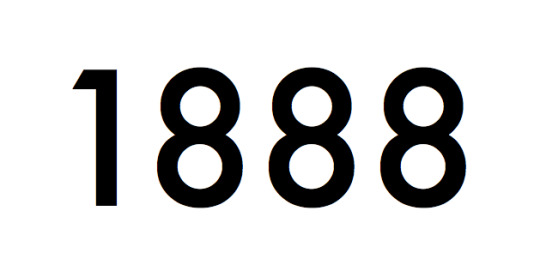
with the same number in Roman Numerals:

You can see how things get a bit complicated! Add to that the necessity to continue inventing (and remembering!) new symbols to represent larger and larger numbers, and you can see why the Hindu-Arabic system works so well.
Understanding this is vital for young children as they grasp number concepts. Without knowing the meaning of written numerals (i.e., that 6492 = [6×1000] [4×100] + [9×10] + 2), kids cannot fully appreciate the value of numbers and how they relate to each other. Children without this knowledge struggle with:
counting,
greater than or less than,
both mental and written arithmetic (for example, knowing what to do with a zero in the tens column when subtracting, or knowing when to exchange a group of ones for a ten),
composing and decomposing number, and
decimals,
along with other fundamental concepts that make it impossible to move on to higher order mathematics.
In Quick Math Jr., we designed Pirate Place Value to use matching and balance to scaffold the concept, first creating matching groups of 10s and 1s…
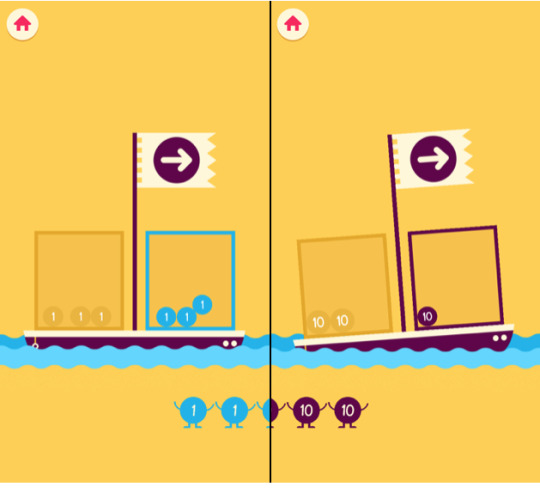
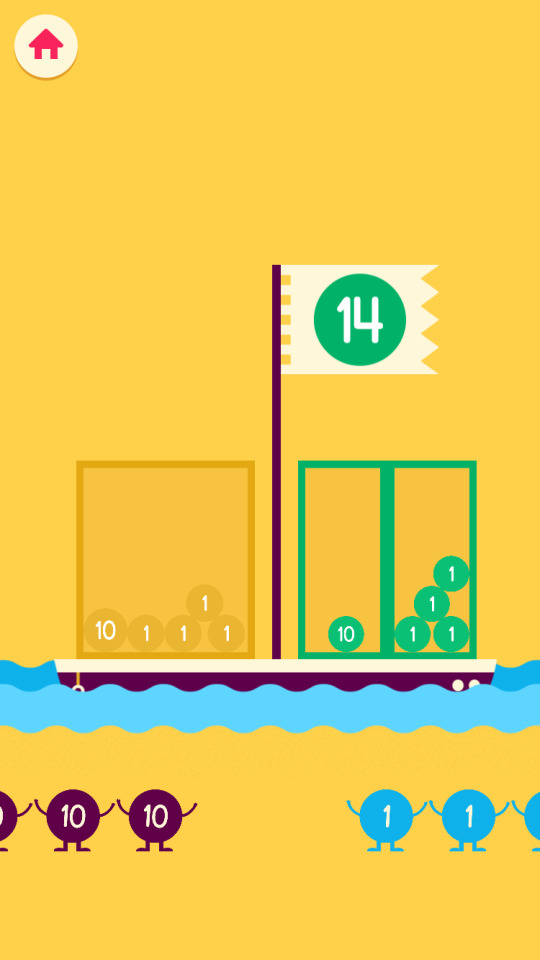
…then matching a whole number using 1s…
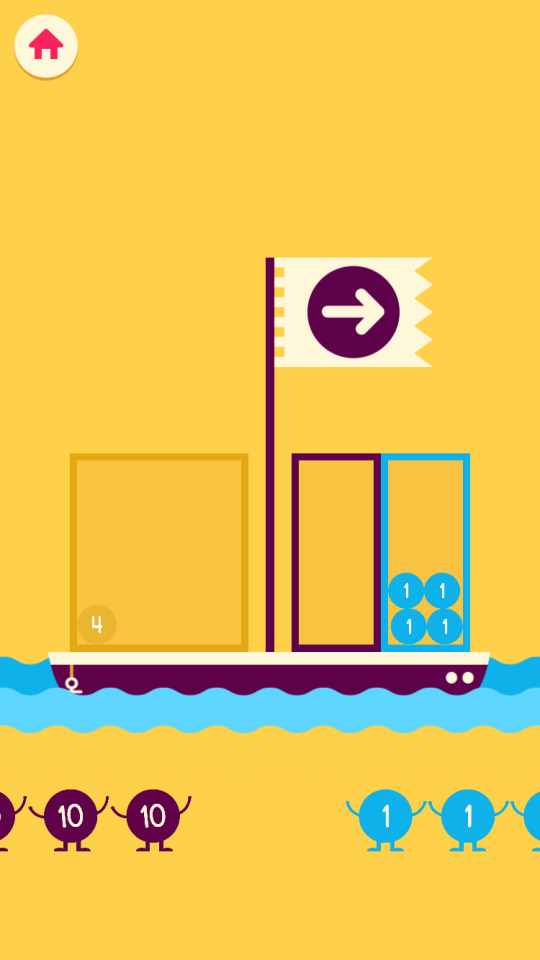
…and finally, practicing place value by using 10s and 1s to create a number and balance the boat.
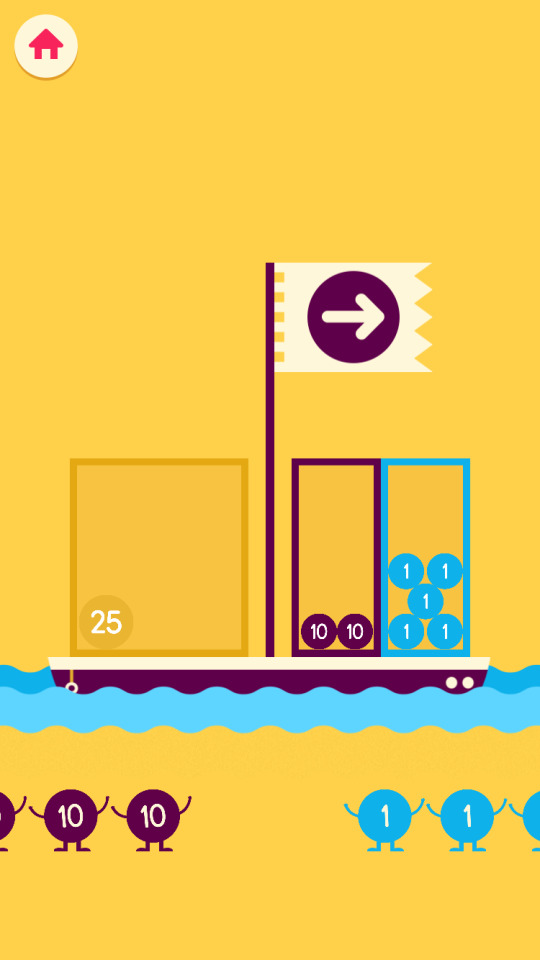
Practicing these skills, in conjunction with exposure to the other concepts in Quick Math Jr. is helpful in forming the necessary understanding of our (totally awesome!) number system.
You can find Pirate Place Value in Spooky Island in Quick Math Jr., which you can find on the App Store.
0 notes
Text
Spotlight on Subitizing
Me: How many dots are there? Child: Three! Me: Good! Did you count them? Child. No. Me: Oh, you didn’t? How did you know how many there were? Child: I can just see!
This is an interaction I had while testing Quick Math Jr. with a kindergarten class, and it’s a pretty perfect example of what’s known as “subitizing”.
“Subitize” comes from a Latin word meaning “sudden” and it refers to the ability to instantly recognise how many object are in a small group without having to consciously count, something most of us do every day without even thinking about it! Generally speaking, adults can subitize 4-5 objects, depending on how they are arranged (for instance, patterns are easier to subitize than random arrangements), but children need to work to develop the skill as an essential component of number sense.
Clements (1999) identified two types of subitizing, both of which are included in “Spotlight on Subitizing” in Quick Math Jr.:
Perceptual subitizing: recognising how many are in a group without grouping or counting. In Quick Math Jr. (example below), children are given a couple of seconds to view the image before the light goes out, to prevent them from using counting to get the answer.

Conceptual subitizing: breaking a group into parts in order to perceive the whole. In the example below, the two groups are easily identified as five and four and can be combined to get a total of nine. This allows us to subitize well beyond the limits of perceptual subitizing.

While at face value subitizing seems pretty basic, many believe it to be a better indicator of a child’s understanding of number than counting. In fact, there is evidence to show that subitizing emerges in infancy, well before children are able to talk at all, let alone verbalise number! But the ability to subitize encompasses several different skills, including:
cardinality - knowing that a number represents the whole set, rather than just being a word in a sequence of other number words.
pattern recognition - an important theme throughout mathematics and a precursor for algebra
number conservation - knowing that a group of objects remains the same, even when they are arranged differently
parts and whole - in perceptual subitizing, seeing that 7 objects can be made up of different combinations of smaller groups, for example, a group of 3 and a group of 4
mental calculation - perceptual subitizing requires adding the two or more groups together to reach a total number
It is for all these reasons that Spotlight on Subitizing was one of the first games we designed when making Quick Math Jr. In fact, our monsters are round because of this game - we aimed to make them as simple as possible in order to avoid unnecessary distractions that would detract from the maths concepts, both when subitizing and throughout the rest of the app.

Find “Spotlight on Subitizing” in Quick Math Jr., available on the App Store.
For more subitizing practice at home, check out Blink, the quick-as-you-can game where two players race to play all their cards by matching shape, colour or number. Great for players 7 and up, this game is excellent for subitizing, matching and lots of laughs!

0 notes
Text
An Introduction to Number Sense
You may have noticed that at Shiny Things, we tend to harp on about something called “number sense”. The reason is, we think number sense is pretty important. In fact, we created an entire app designed to help children develop a strong number sense in Quick Math Jr. So today I thought I would share a bit with you about what number sense is, and why it is so very important.
What is Number Sense? Number sense is knowing what number means. It is, for example, knowing that “5” refers to five objects, as opposed to merely being the word that follows “four” in the counting sequence.
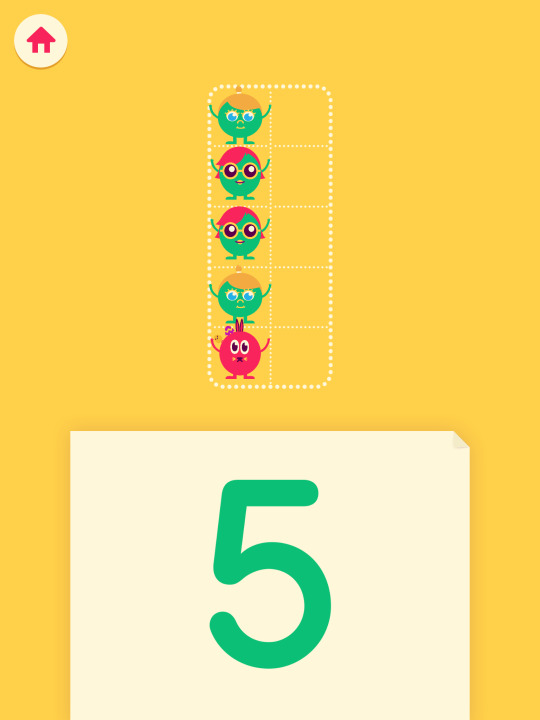
A student with good number sense:
represents a number in many different ways, whether that be with a numeral, a set of objects or their fingers, and uses these different representations in appropriate contexts
understands that a number refers to a quantity
reasons flexibly with numbers and perform mental calculations with reasonable fluency
understands the base ten structure of our number system
understands how numbers relate to each other, for example, that 12 is larger than 9
knows that numbers can be broken into parts or combined to form other numbers
Why is it important?
Research shows that developing a strong number sense as early as preschool has a huge impact on future mathematics understanding and achievement (Jordan et al., 2009, Geary, 2011). For that reason, it is absolutely vital that young children have lots of practice and are exposed to a variety of different number representations and experiences in both formal and informal settings.

Image by Hugo Cardoso via Flickr
How do I help my child develop number sense?
The good news is, kids love numbers! They love counting and have an innate curiosity when it comes to mathematical thinking (just think about how invested they are when it comes to determining which is the bigger slice of cake!).
That being said, there are LOTS of ways you can point them in the right direction:
when shopping, ask your child to look at two products and help you decide which one is cheaper. This gets them thinking about what the numbers mean and the importance the position of the numbers is in determining quantity (magnitude and place value)

Image by USDA via Flickr
children love helping, so ask them to set the table. To do this, they will have to determine how many knives and forks they will need, and allow one knife and one fork per setting (counting, cardinality, one-to-one correspondence)
cook with them. Cooking is rich in maths concepts and you get the added bonus of a delicious treat when you finish (after the washing up…)! You can also double or halve the recipe to make it a bit more tricky (fractions, quantity, counting)!
board games - another source just bursting with maths concepts. Kids have to recognise the number on the dice and move their piece a specific number of places. Depending on the game, there are also opportunities to deal with money, collect items and match objects. You can also ask questions like, “how many do you need to roll on the dice to overtake me?” or “how many more items do you need to collect to win the game?” (counting, number recognition, addition, comparing magnitude, one-to-one correspondence, cardinality).
“Guess my number” games for the dinner table or long car trips - choose a number within a determined range (you can go as low as 0-10 for really young kids and the sky is the limit for older kids!) and kids have to guess what it is WITHOUT just throwing out any old number until they land on the correct one. They can ask questions like “is it more than 7?” or “is it a multiple of 5?” in order to narrow the range of possibilities.
In summary, number sense is important. It underlies all mathematical thinking and is essential for mathematics success throughout life. Fortunately, there are plenty of opportunities out there to guide children as they experience and learn about the wonderful world of numbers!

Quick Math Jr. is an app dedicated to number sense. In developing the 12 mini-games, we aimed to provide a comprehensive, dynamic and most importantly, fun experience for all players. We hope that the positive experience they have with mathematics fosters a love for number that has lasting benefits.
Find Quick Math Jr. on the App Store
References:
Jordan, N. C., Kaplan, D., Ramineni, C., & Locuniak, M. N. (2009). Early math matters: Kindergarten number competence and later mathematics outcomes. Developmental Psychology, 45, 850–867. doi:10.1037/ a0014939
Geary DC (2011) Cognitive predictors of individual differences in achievement growth in mathematics: A five year longitudinal study. Developmental Psychology 47: 1539– 1552.
#math#maths#mathematics#kids#number sense#number#numbers#counting#education#kids apps#parents#teachers#math apps#mathsapps#monsters
0 notes
Text
5 Products to Help Build Number Sense
At Shiny Things, we’re pretty passionate about kids getting a good start in maths, so we’ve put together a short list of products that are great for building number sense in young minds. We hope you love them as much as we do!
1. Blink - The World’s Fastest Game!

Blink is the quick-as-you-can game where two players race to play all their cards by matching shape, colour or number. Great for players 7 and up, this game is excellent for subitizing, matching and lots of laughs!
Available on Amazon.com
2. Match It! Numbers

With 20 three-piece puzzles, Match It! is a wonderful way to learn about numbers 1-20. Players join numerals with their corresponding sets and number words to complete puzzles. Perfect for ages 3 and up.
Available on Amazon.com
3. Melissa and Doug Classic Wooden Abacus

This wooden ‘calculator’ is a great way for kids to explore number, patterns, colours, sequencing and much more! It also comes with 8 extension ideas for even more learning opportunities. Great for kids 3 and up.
Available on Amazon.com
4. The Very Hungry Caterpillar

An absolute essential for young kids (I remembering reading it when I was very young!), The Very Hungry Caterpillar teaches counting sequence, number recognition, one-to-one correspondence and cardinality. It is beautifully illustrated and enjoyed by both big and little kids the world over!
Available on Amazon.com
5. Ratuki

Be the first player to slam a 5 on the pile and yell “RATUKI!” and you keep the stack - first to 100 cards wins! Great for using different number representations, number order and fast-paced family fun! For kids ages 8 and up.
Available on Amazon.com
0 notes
Text
Making apps for kids: Part 4
Some lessons learned in the making of Quick Math Jr.
Welcome to the final post of our Making Apps for Kids series! Check out parts 1, 2 and 3, or keep reading for Part 4.
Designing touch screen interactions for little fingers
Have you ever watched a young child use a touchscreen device and just thought… wow!?

It’s common to hear young children today described as “digital natives”; so comfortable with technology that they’re navigating it with ease before they can even walk or talk.
Which makes designing apps for this “digital native” generation pretty easy, right?
Well… not exactly.
In my previous posts I’ve touched on the value of frequent user testing with kids during our development process. Yes, we’re looking for evidence of high engagement, learning progress, and the usability of our app, but we’re also simply watching the way kids interact with the app and with touchscreen devices in general.
Because, almost always, we see things we hadn’t even thought to consider!
With all the “digital native” hype it’s easy to overlook the fact that there are differences in the ways adults and children interact with mobile devices. Remember that these devices, and the developer guidelines supporting them, have been created with the “typical” adult user in mind, not a still-developing child.
When designing an app for you children you need to factor their developing cognitive, emotional and physical motor skills into your decisions, digital natives or not. Here are some of the things we’ve found that you might want to consider:
Physical limitations
Most obviously, young children are smaller and weaker than the average adult, so:
Watch for the way children hold devices while playing. Can they still comfortably navigate the app?
Reconsider interactions which require lifting, carrying, or shaking the device, or be prepared for sore arms and flying iPads! It’s very difficult for kids to hold or carry a device and interact with it at the same time. We often see children place the tablet on the floor and then lie or sit over it. This means that the device inadvertently slides around during play, and interactions triggered by moving or shaking the device could get in the way and potentially frustrate the user.
Poor motor skills
On top of being physically weaker than the “typical” user, young children are also hampered by their developing motor skills, so:
Don’t require interactions with sustained screen contact. When dragging, young children struggle to maintain finger contact with the screen. Taps or short drags are easier for children to manage. Alternatively, allow children to continue an interaction after losing contact with the screen. For example, Quick Math Jr. includes a handwriting component where children can remove their finger from the screen but can then continue drawing the same character.

Make targets nice and big. Even though they have smaller fingers, children are less accurate then adults when it comes to hitting small targets.
Make sure interactions happens on touch rather than release. Children often lack the motor skills for quick finger movements, so a child’s “touch” is often really a touch-and-hold.
Egocentricity
Children touch everywhere. Sometimes deliberately, sometimes not. Children have an egocentric view of the world (more so than adults!). They essentially expect touch-screens to read their mind, and become frustrated when the device responds in an unexpected way, such as when deliberate touches are ignored or when accidental touches are not ignored! So:
Control for extra touches. Performing gestures with one finger can be difficult for young children, who will often use two fingers (e.g. both index fingers) to drag a single object. Children intuitively expect this to work the same way as a single touch - just as it would in the real world!
BUT ignore extra hands on the screen. Children will often hold the device with thumbs overlapping the screen, or rest either hand on the screen while they are playing. They do not expect this to trigger any behaviour.
AND support deliberate multi-touch. Children will often play together on the same device (even when they all have their own!). They expect to be able to interact with the same screen at the same time. This also allows children to use multiple fingers for multiple simultaneous interactions, another thing we often see young children do.

Image credit: Thijs Knaap
Finally, be prepared for all sorts of unexpected gestures and make sure you TEST WITH KIDS! It really uncovers all sorts of things we as adults would never think to test. For example, we found a bug in Quick Math Jr. when a young tester decided to “push” an animated train by repeatedly tapping and dragging on the screen during the animation, resulting in a crash. Unsurprisingly, we hadn’t tested that one in the office!
We hope you found this post helpful! For more information check out the previous posts in our Making Apps for Kids series: Part 1, Part 2 and Part 3
Want more tips like these? Sign up to the Shiny Things mailing list and have them delivered straight to your inbox!
2 notes
·
View notes
Text
teaching
what people think i do

what i actually do

2K notes
·
View notes
Photo

There’s a lot of exciting stuff happening at Shiny Things! Make sure you keep up to date with Shiny Mail. Sign up here: http://eepurl.com/bQ8fs1
1 note
·
View note
Text
Building Sustainable Revenue in the App Store
If you’ve ever released a game or app in the app store, you are probably familiar with this curve:

For those who aren’t as familiar with the app store (hello, web developers!), you may be expecting something a little more like this:

When people think about building a business they think about growing their paying customer base over time. In kids apps and games the convention is that it’s all about getting hits. You spend months or years, invest a big wad of cash, promote the heck out of your app and then hope that you make enough money in those first crucial weekends to cover costs.
If your app is a real hit you might still be making money months (or years!) later but if you don’t get it right then all that work goes down the drain. Which leaves you either scrambling to release another app or worse, packing up shop.
At Shiny Things we’re trying something different.
The Release
After we released Quick Math Jr, we were ecstatic. It represented some fantastic achievements for us. We’d created a learning engine that adjusted its difficulty as kids played. We’d created a reward system that kids (and adults!) absolutely loved. We’d built games that taught numeracy skills in innovative ways that nobody else was doing. Most importantly, kids were having so much fun playing it.
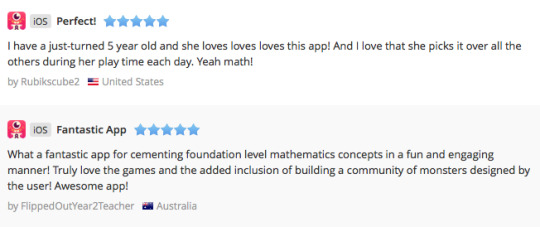
But even after the release, we still had a bunch of ideas we wanted to explore. Generally these would be released in Quick Math Jr. 2 or Quick Math Jr Plus a year or so later.
Instead we bucked tradition and two months later released a new mini-game and a Christmas update. At this point, not only were kids hooked on learning maths, but we were hooked on improving Quick Math Jr!
Continuous Improvement
Since we originally released Quick Math Jr. in October 2014 we’ve released four major updates, each a massive improvement on the one before. These releases were based on what we saw kids doing in the classroom, the feedback our users gave us, the lessons we’ve learned since starting this company and how we see our business growing sustainably in the future.

These regular updates have been liberating. They’ve allowed us to try new ideas and build on the work we’ve already done without spending a lot of time building a completely new product. We know we can’t get everything right the first time, but once we see how our users react to something, we have a much better idea of where to go from there (though despite testing extensively in the classroom we can’t really know how kids “in the wild” will do with our games, and we don’t know what parents will understand and buy until we release).
Some great innovations have come from this process - the idea for our report card came from user feedback. We also altered our account-creation flow to further emphasise personal expression and engage our users, and we upgraded our progress screen to give children feedback about what they were learning. Most importantly, we decided to switch to a free to play model with in-app purchases to get more content.

Our first free release included the Spooky Town In App Purchase
The switch to being a free app was a big deal. We’d never tried the business model and only a few apps in our category were doing business that way.
First we decided to test the concept - we released an update that switched us over to free with one IAP. After a couple of weeks of data we came to the conclusion that, even though only a small percentage of our users bought the IAP, it was enough to beat our revenue from before.
With our proof-of-concept out of the way, it was time to get the real deal into the App Store. We had a hypothesis: with at least two individual purchases and a bundle we’d get many more conversions. We didn’t want to just throw some content together for a quick release, so we worked hard on developing some fantastic new content. After three months of sketching, classroom testing, implementing and re-implementing (and re-re-implementing), we were finally ready to unleash it on the public.
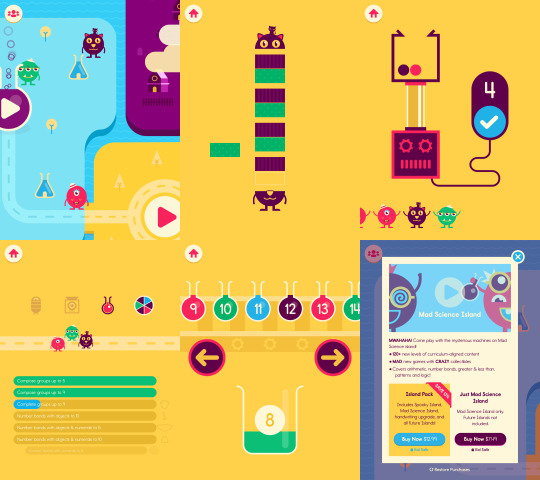
Our Mad Science Island update is huge. We’ve added a third island of content with three new games and a heap of new items to win. It’s by far the most polished product we’ve ever released and we’re very happy with it.
The best part of this approach has been making an app that really is great for our customers. Ultimately we don’t want to be in the business of one-off purchases - apps that are opened one weekend and never opened again. We want to be making apps that kids open all the time, turning their minds-off screen time in to minds-on (learning) screen time.
Rewarding Early Adopters
We’ve also done something else with this new release - if you buy our Island Pack, we don’t just give you a discounted price, we’re also including every island we release in the future. This is a tremendously good deal and for us it’s very exciting. We get to reward our early adopters, the ones who believe in us most!

Releasing continuous improvements is important to us; it lets us know we’re on the right track and it helps us make the best product possible. This means that, while we know our app is great right now, we also know it’ll be even better in the future and if you’re willing to pay to come on that ride, we’re willing to sweeten the deal.
This sort of approach has worked well for other indie developers in the past. Many of you would be familiar with Minecraft’s pricing structure. The Alpha releases were very cheap, then as they added more features and released more stable builds, the price rose to where it is today. Pinboard famously charged a fraction of a penny more for each successive user, though they’ve since simplified the pricing. Modern apps are always improving, so it makes sense for the price to go up as the product gets better.
It may be almost a year since our first release, but we still have a lot more to come! We have two new islands in the pipeline, both with their own exciting new games and items. We have a new system for guiding kids through our games in development, plus some other ideas we can’t wait to show you.
We think that by continuously improving our product we can build something really amazing and, by rewarding our customers who jump in early, we can make a sustainable income too!
If you’d like to try Quick Math Jr. with your children (3-8), we’re free on the App Store. You can learn more about the learning benefits on our website.
Post written by Ben Taylor. Stay tuned for Part 4 of our Making Apps for Kids series, coming soon!
1 note
·
View note
Text
Making apps for kids: Part 3
Some lessons learned in the making of Quick Math Jr.
Over the past few weeks we have been writing a series of blog posts about the many, MANY lessons we are learning as we create our app, Quick Math Jr. Check out parts 1 and 2, or read on for part 3!
Getting schooled
We do a lot of our user testing in Kindergarten classrooms. Testing with group of kids at a time can be chaotic, but it also has several advantages.
For us, it allows testing with hundreds of kids over the course of development. For our testers, it offers a familiar and comfortable environment, surrounded by people they know (plus one or two visitors!).
The greatest advantage, however, is the opportunity for us to collect honest opinions from our testers. When kids are playing an app alongside their friends, they talk to each other as they play. In doing so they naturally verbalise their thoughts about the app, and we are right there to hear it!
Kids this age are becoming much more socially aware. They are also developing an understanding of their own learning and starting to compare themselves and their performance to that of their peers. Much of what we typically hear in a testing session is reflective of these developmental changes.
For example… “This is SOOO easy!”
As soon as one kid says this, you know you’re about to hear a chorus of agreement (even from that kid who saying it was too hard just moments before!). Kids this age are conscious of being ‘big kids’ now, and distinguish themselves from younger kids by rejecting things they regard as ‘babyish’. Naturally, they don’t want any of their peers to think of them as babies either, so are quick to join the “SO easy” bandwagon!
In her book, Design for Kids, Debra Levin Gelman suggests that it’ s hard to pin down exactly what makes something “babyish” but that typically “children call something ‘babyish’ when it’s not difficult or challenging enough for them”.
On the flip side, there is:
“Grrr, I HATE this game!”
This is not exactly encouraging to hear, but it is important feedback. Typically we find that this too is related to the challenge level of the app, but in this case it often means the app is too hard. While a too-easy game may be boring, too-hard is frustrating. Kids this age are conscious that they are struggling, become frustrated with themselves and project that frustration onto the app. Takeaway: It’s hard but necessary to keep kids this age in the difficulty sweet spot. Quick Math Jr. has an adaptive difficulty engine that tries to keep players in their zone of proximal development . This means that new players are presented with easy challenges to start, then the difficulty increases based on their performance. Classroom testing sessions let us know when this is not working quite quickly enough!
“Omigosh, Anna is up to one hundred!!”
Five year olds get really excited when they see numbers over 100. It’s amusing, but it’s also reflective of their general thirst for knowledge about the world, and their developing awareness of their learning achievements.
One mistake we made in the original version of Quick Math Jr was hiding learning progress from players (it’s available to parents via a parental reporting system).
We assumed that kids would be uninterested in their learning progress or, worse, even find it demotivating. We assumed that the in-app reward system would offer feedback and motivation enough for kids to continue playing the app.
It took us an embarrassingly long time to realise the error of these assumptions!
By design, the early levels of Quick Math Jr are too easy for most 5 year olds. The games get harder but, because we’d hidden the progress system, kids had no way to know this. Eventually, enough kids complained about playing the same game over and over again for us to wake up and realise something wasn’t quite working.
As it turns out, 5 year olds both understand and are intrinsically motivated by learning goals. We recently tested a simple change to show kids their learning progress as they played. We didn’t have much of an idea about what to expect, but the results were amazing! Kids were much more motivated to continue playing a game when they could see that they were moving through levels of learning content.

We shipped the new progress indicators in our latest update and, what do you know, we’re seeing a 40% jump in playtime. Just one more reminder of the importance of listening to your user!
In short, testing sessions are extremely useful for learning about your product, and what is and isn’t working. However, and perhaps more importantly, they can also be great way to learn about your users and their needs.
Article by Jane Abrams, Shiny Things, Educational Content Development.
Stay tuned for the final post in this series (for now…), coming soon!
2 notes
·
View notes
Text
Do you even BODMAS?
If you dabble in the world of social media, chances are you have come across a post like this:

Following is generally a variety of answers (for the above question: 56, 0, 50, 54, 42, 14), and a discussion that is best described as Godwin’s Law embodied.
At Shiny Things, we also get a lot of emails from Quick Math+ users who become frustrated when the app has a different answer to the one they have calculated and consider correct. In essence, we are told that our maths is wrong.
Ouch.
So why all these different answers and opinions? Why such spirited debate and high emotion over what is, really, a relatively simple question?
Order of Operations.
You might remember it as BODMAS (or BOMDAS) , BEDMAS, PEMDAS or even “Please Excuse My Dear Aunt Sally”. It was, among many other things, drilled into us in primary school, but as adults, it is something we rarely use and as a result, it tends to be forgotten.
So what is it?
Order of Operations is a set of rules (used in mathematics, science, technology and most programming languages) that define the order in which the operations in an equation are to be performed. That order is as follows:
1) Parentheses 2) Exponents and roots 3) Multiplication and Division (left to right) 4) Addition and Subtraction (left to right)
Thus, the above equation is solved:

But why?
Quite simply, to avoid situations where Quick Math+ users become frustrated. Well, ok, it’s a little more global than that. To avoid ambiguity. The Order of Operations rule, no matter how seemingly arbitrary or forgettable, means there is one answer and only one answer.
As a general rule, this lack of ambiguity is exactly the type of thing mathematicians, scientists and computer programmers value. Highly. Very highly (seriously. Do you know any programmers?).
Ok. But why can’t we just use parentheses?
A fair point. There would be no rules or mnemonics to remember for starters. But I’ll use another example to demonstrate why just adding parentheses to indicate order is not an ideal solution (especially when it comes to algebra!):

Parentheses can be handy (especially when you want to add an aside in text), but as you see in the above equation, they can also make things appear ridiculously complicated. Order of Operations allows us to simplify without changing the essential structure of the equation or, most importantly, the answer.
Thanks, Shiny Things! You’ve really cleared it up for me!
You are most welcome! I certainly hope this information will be useful next time you want to look intelligent on social media. Or get into a spirited debate with someone who has clearly not read this post. Both will likely happen. To finish, I will leave you with a practice example from Quick Math+ for you to ponder. Good luck!

Article by Alison Bryan - Shiny Things, Educational Content Development
Stay tuned for our next post, Part 3 in our critically acclaimed series (ok, that might be an exaggeration...), Making Apps for Kids.
0 notes
Text
Making apps for kids: Part 2
Some lessons learned in the making of Quick Math Jr.
Welcome back! This is part 2 of our blog series on what we learned while researching and developing Quick Math Jr, a mathematics learning app for children aged 4 - 6.
In my first post I wrote about the need to minimise distracting material when designing apps for young children. In this follow up post, I’m going to discuss motivation.
So, you’ve made sure kids aren’t getting distracted by a bunch of bells and whistles, but how do you make sure your app is interesting enough to get kids playing it in the first place?
Just like big people, little people need to find something in a task that motivates them to want to continue with it. Motivation comes in two flavours; intrinsic and extrinsic. Intrinsic motivation is when we perform a task because the task itself is enjoyable. Extrinsic motivation is when we perform a task in order to get some other reward.
Intrinsic motivation is the more powerful motivator, but extrinsic motivators are much easier to provide! We’ve all been tempted to fall back on candy-based bribery (an extrinsic motivator) whenever we’re trying to convince a reluctant human to do something they are not particularly inclined to.
However, consider the type of message we send when we rely on extrinsic motivation in a learning app. Kids already know that rewards are offered when the task itself is not inherently motivating. They might be rewarded with treats or money for completing chores, but they never get rewarded this way for things they enjoy doing, such as playing with their toys.
When we offer extrinsic rewards for learning something we are equating learning with a chore - an unpleasant thing which must be put up with in order to reap some other reward - and any value the child may have found in the task itself is completely overshadowed. This is not a desirable outcome.
So, where does this leave developers trying to create a compelling learning game? Are in-game rewards always a complete no-no?
In Quick Math Jr, we settled on a mix of intrinsic and small extrinsic motivators.
One way of helping kids this age to find a task intrinsically motivating is to make them feel like a part of the experience by offering them opportunities for personalisation and self-expression.
In Quick Math Jr. players create their own collection of monster characters, which then appear throughout the app. The aim here is to help kids feel like that they are a part of the “story”. Sure, the story in this case might be something as simple as monsters getting on or off a bus, but when the characters are their own and they control the action, a simple task suddenly becomes a lot more compelling. When we hear kids talking to their monsters as they play, we know we’ve tapped into their intrinsic motivation!
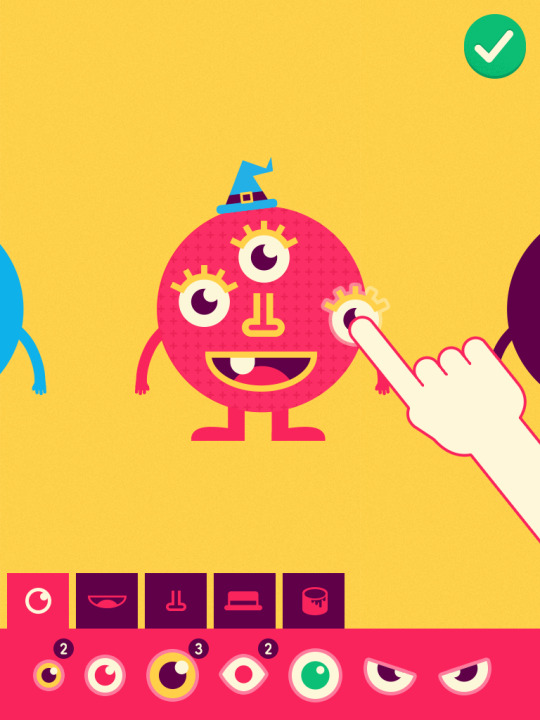
Of course the ‘story’ in this case also serves the dual purpose of helping to ground abstract mathematical principles. Children are much better at solving mathematic problems when the problems relate to their experiences in the real world. For example, keeping count as monsters arrive and leave a house is much more accessible for kids that then same problem presented in numerical form.
Quick Math Jr. also offers small, extrinsic rewards for kids to earn as they play. Since studies have found that external rewards can have a negative impact on intrinsic motivation, we decided to step very carefully here.
After a player completes a round of games, they can spin the prize wheel to earn one or two new parts for their monsters. These rewards are small, low-stakes, linked to the core game play and the intrinsic motivators, and are awarded for effort rather than progress. They also offer some random surprise, as new parts are revealed with each spin.

In this way we hope to add a little extra fun to the games without detracting from the intrinsic motivators for playing or separating out the “learning” from the “fun”!
In my next post I’ll continue on the topic of motivation and discuss the impact of game difficulty. Check back soon!
#education#educationapps#educhat#edtech#pedagogy#teachers#parents#kids#kids apps#appdesign#appdevelopment#research based#math#mathchat#mathematics
3 notes
·
View notes
Text
Making apps for kids: Part 1
Some lessons learned in the making of Quick Math Jr.
Children are not mini adults.
That probably isn’t news to you, but when making apps for kids it’s important to keep that in mind. Children have distinct developmental limitations - physical, cognitive and emotional - that they can’t simply ignore or decide to overcome. We want to make kids feel powerful when they use our apps, not frustrate them by requiring abilities beyond their level of development.
This series of posts will cover some of the things we learned while researching and developing Quick Math Jr, a mathematics learning app for children aged 4 - 6.
First up: Attention v. Distraction
Keeping my attention on anything is HARD… and I’ve had 30 years of practice. This is because our brains have limited attentional resources that are constantly being overloaded by the distractions in our environment.
The human brain tries to manage these distractions through selective attention. This is the ability to maintain sustained attention on one thing while ignoring other, less relevant, things.
However, as you are probably aware, even in adults this system isn’t foolproof. It fails. Often.
For young children, maintaining attention and focus is even more difficult as their brains are still developing this ability for selective and sustained attention. Without a developed ability to filter out extraneous information, all the information in the environment is in competition for a child’s focus. This means a child’s attention is both fleeting and highly susceptible to distraction.
With all that in mind, we formulated a couple of guiding principles when designing QMJ:
1. Keep it short and simple
Complex instructions and lengthy tasks are a no-no for this age group. With QMJ, we catered for short attention spans through a series of self-contained mini-games. Each game can be explained to the child in a few simple steps and each round only takes a few minutes to play.

Side note: Not only does breaking up information into manageable ‘chunks’ allow young learners to maintain focus, it also enables interleaving of content. Recent research has found that practising a variety of separate but related skills in succession is more effective for learning new skills than repetitive drilling of the same task.

2. Instructions should be active rather than passive
This is one we learned a little late.
We wanted to avoid spoken instructions in Quick Math Jr. but found that many kids needed guidance on how to play when they first started the app. We thought a short, visual tutorial would do the trick.
We were wrong.
The 5 second video did help some kids - enough to get it shipped in the first version - but overall we found that many kids seemed to forget what they had seen almost immediately, if they had paid attention at all!
When we had a think about this it was pretty clear what was going on: within the space of a few seconds kids see a video without context or obvious relevance, followed by a series of cutscene animations, and then a new and completely different scene.

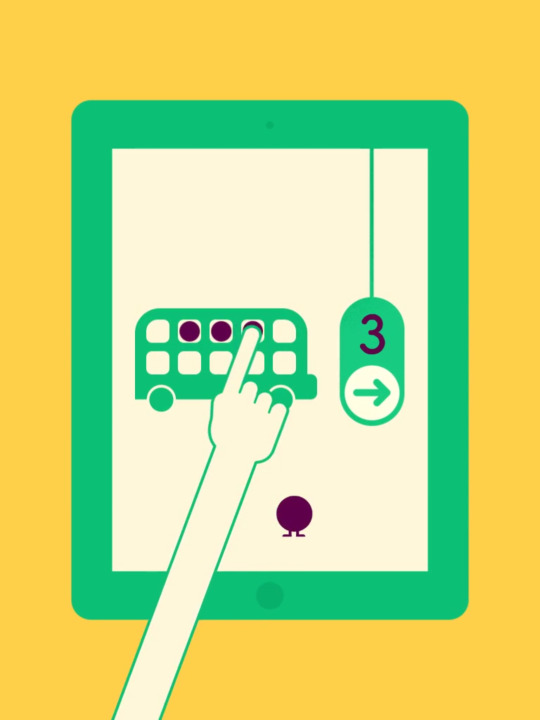
Our guess is that all of this is simply causing cognitive overload, and the result? The tutorial video is completely forgotten.
In hindsight, short instructions given while kids are playing would be a better option. Kids will be much more likely to pay attention and remember instructions if they are given in context and can be put into practice right then and there, rather then having to remember and apply them at a later point.
We’re currently working on some new ideas for more meaningful instructions in QMJ - check back soon for an update!
3. Avoid unnecessary distractions
Packing an app with images, sounds, and animations may intuitively seem like a good way to engage young children, but when everything on the screen does something it’s very difficult for a child to stay focused on the important elements of a task.

In fact, research has found that even the colourful images in mathematics textbooks are distracting enough to have a detrimental impact on learning.
Of course, no-one wants to remove all of the fun from an app, and if an app is so boring that no child will pick it up the in the first place, you can bet it isn’t helping anyone to learn.
This means walking the fine line between engagement and distraction.
In the design of Quick Math Jr. we wanted something that was both visually appealing but not distracting. To achieve this, we worked with a limited colour palette and removed extraneous detail. When a child is completing a learning task, everything on screen is related to that task. Animations, music, and background images are mostly limited to menu screens and, since fast-paced animation has been linked to short-term detrimental affects on attention, we avoided this altogether.
We think we arrived at a great compromise by creating an app that’s engaging to interact with while keep the focus firmly on the learning. We like to think it looks pretty great, too!

Post by Jane Abrams, Shiny Things, Educational Content Development.
Stay tuned for Post 2, coming soon... (as an added bonus, eagle-eyed readers will note that this post contains a special sneak preview of one of the games from a brand new town, which is due for release in the very near future!)
#education#educhat edtech#parents#teachers#pedagogy#kids apps#preschool learning#appdevelopment#appdesign
4 notes
·
View notes
Text
Introducing the Quick Math Jr. Report Card!
The introduction of our Quick Math Jr. report cards has been a cause for mass celebration at Shiny Things!

^ Mass celebration at Shiny Things (artist’s impression)
The report card gives you a comprehensive overview of how your little monsters are travelling as they navigate the Quick Math Jr. Islands, playing, learning and developing the number skills essential for maths understanding. The information is layered so you can do a quick progress check or go for a more in-depth experience, learning about the various skills involved in each game and where they fit in international curricula.
Layer 1 - an overview
Heading into the main reports page (which is protected by a parental gate to prevent any little monsters making unwanted purchases or visits to your Facebook page/account!), you’ll find a monster for each profile and progress bars for each island:

A quick glance gives you a summary of how each player is progressing though the individual Islands. The bold shading indicates areas of mastery, and the slightly lighter shading represents any progress from the last play.
Layer 2 - a slightly more specific overview

Tapping on a player’s profile reveals another progress screen, this time broken down into the different games within each Island. From here you can spot any areas that may be causing trouble, as well as those areas in which your little monsters feel more comfortable.
Layer 3 - skill areas

From there, tap on any game to see a complete list of the skill areas covered. Green areas indicate mastery of a skill set (yay!) and blue is the area your child is currently working on. Tapping any of the bars reveals…
Layer 4 - specific skills and curriculum links
… the final layer! A breakdown of the skills in that area, as well as how those skills align to the Australian National, US Common Core and UK Curriculums.

It’s a lot of information - we know! However, we consider all of it to be useful, particularly as a reference point for both parents and teachers. We want you to know that the time spent on Quick Math Jr. is relevant to the work your little monsters do in preschool and school, as well as helpful in practicing the fundamental skills to build a strong and enduring number sense!
Download Quick Math Jr. for FREE here:
https://itunes.apple.com/app/quick-math-jr./id926078360?mt=8
1 note
·
View note
Quote
In a fixed mindset students believe their basic abilities, their intelligence, their talents, are just fixed traits. They have a certain amount and that's that, and then their goal becomes to look smart all the time and never look dumb. In a growth mindset students understand that their talents and abilities can be developed through effort, good teaching and persistence. They don't necessarily think everyone's the same or anyone can be Einstein, but they believe everyone can get smarter if they work at it.
Stanford University’s Carol Dweck on the Growth Mindset and Education
2 notes
·
View notes
Text
Mindset
I don’t play tennis. I don’t like it. I've played a few times and I’m not any good. But rather than putting any effort into trying to learn or improve, I just don’t play at all.
I’ve been this way for as long as I remember. Revelling in my successes but shrinking away the moment I came up against a mistake or a challenge I could not overcome with ease. If I am not good at something, I don’t like it and won’t participate.
Growing up, I was given plenty of praise. I was told I was “smart” or “gifted” or “good” at something, and it’s only been later in life that I discovered my irrational unwillingness to play tennis and this particular type of praise might be linked.
The Research
Carol Dweck has spent the better part of the last 4 decades studying praise and how it influences achievement and motivation. Praising students for their intelligence may boost their confidence, but what happens when they then are faced with failure or difficulty?
To find out, Dweck gave students an easy test followed by a single line of praise. The praise was either for their intelligence (“You must be smart at this”) or for their effort (“You must have worked really hard”).
After this, all students were given some harder problems to do, and then a second easy test. The results on the second easy test showed a big difference between the two types of praise! The group who had been praised for their efforts improved their first score by about 30%. However, the students who were told they were smart scored lower than their initial test by about 20%.
What happened?
“When we praise children for their intelligence,” Dweck wrote in the study summary, “we tell them that this is the name of the game: look smart, don’t risk making mistakes... Emphasising effort gives a child a variable that they can control... Emphasising natural intelligence takes it out of the child’s control and it provides no good recipe for responding to a failure.”
The Mindsets
This study really is an excellent illustration of the profound impact mindset has on motivation and success, as well as a wonderful demonstration of how influential something seemingly trivial, such as a single line of praise, can be.
The students praised for intelligence adopted the fixed mindset - a belief that intelligence is static and predetermined. When confronted with the more difficult questions, they attributed their failures to a lack of ability which, as we saw, had a significant and immediate effect on motivation and performance. People with this mindset tend to avoid challenges (like learning to play tennis), give up easily, ignore any negative feedback, believe effort is futile and feel threatened by the success of others, which all sounds pretty grim! Yet this is exactly what we are encouraging albeit unintentionally, when we praise ability.

The other students, however, adopted the growth mindset - achievement is directly positively related to purposeful engagement and effort. They flourished when presented with a challenge because they correctly saw it for what it was: learning. Experiencing the discomfort of making a mistake or coming across something you cannot do (for example, infants learning to walk) allows the brain to adapt to new models which is, again, learning. People with the growth mindset tend to see opportunities in mistakes, persist after setbacks, take and use criticism to grow and are inspired by others’ success.
What does it mean for me?
Clearly, not all praise is created equal. While the relationship between praise, mindsets and performance is not as simple as it may appear (nothing in psychology ever is...), there are certainly methods of praise and encouragement that are more effective than others (these are also useful for self-talk if you are particularly hard on yourself!):
emphasise effort when giving praise
equally, emphasise effort when evaluating a poor performance
praise the process over the result
try to avoid praise that encourages comparisons
be interested in mistakes and challenges rather than dismissing them as due to a lack of ability
The good news
Our brains are spectacularly adaptable, so even if you, like me, you recognise that you have a fixed mindset later in life, the research shows that you can learn to adopt the growth mindset. Carol Dweck says, “Changing mind-sets is not like surgery. You can’t simply remove the fixed mindset and replace it with the growth mindset”. It just takes a bit of effort!
Article by Ali Bryan - Shiny Things, Educational Content Development
Continue reading more on Carol's research and work at her Mindset website.
#raisingkids#students#influence#childrenmindset#educhat#education#teachers#teach#motivation#ability#braindevelopment
0 notes